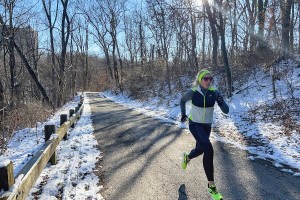I Tried It: Mount Kilimanjaro Workout with Preston and Steve’s Nick McIlwain
Two questions crossed my mind as I strolled into East Norriton’s Retro Fitness on Monday afternoon, fully prepared to have my butt whooped: How does someone train to climb a mountain in a place like Philadelphia? And how on earth did Preston and Steve Show producer and on-air personality, Nick McIlwain, who once busted his Achilles on the dance floor at a wedding, get roped into climbing the tallest mountain in Africa?
But as I followed his trainer, Nick Rueger, to the gym floor and caught a glimpse of McIlwain’s face, already glistening with sweat as he worked his arms on a weight machine, I realized this was no time for questions. I hopped on to the elliptical for a quick warm-up. It was time to get to work.
Rueger set up stations for a circuit workout. First it was 20 squats on the bosu with a medicine ball overhead, followed by 15 seconds of mountain-climbers (why not?!). Next we did 20 weighted rows in a squat position, and I got in 12 (girly) push-ups while McIlwain did 15 or so high jumps onto a platform. Then I did the jumps as McIlwain did his push-ups (they were real ones, I checked). “One down, seven to go,” Rueger said. We completed the circuit eight times.
The conversation loosened as the endorphins began to flow. “So how exactly do you train someone to climb a mountain?” I asked Rueger between sips of water. “When you climb a mountain, you’re using your entire body,” Rueger said. “With these workouts, I aim to work every muscle in Nick’s body.” (He did. Muscles I didn’t even know I had are sore today.)
Back in January, McIlwain was challenged to hike up Mount Kilimanjaro to raise money and awareness for Sanfilippo syndrome, a genetic disorder that McIlwain says “is like Alzheimer’s in children.” Kids who are born with it develop normally, but as the syndrome progresses, the children degenerate, losing the ability to speak, walk and eat before eventually losing their lives. McIlwain and five other men, including the father of two boys with the disorder, will be climbing the mountain with Team Sanfilippo to support the search for a cure. So far the group has raised upwards of $10,000 for the cause.
Working for a morning show, McIlwain doesn’t lead the typical 9 to 5 lifestyle. He’s up at 4 a.m., at work by 5:15, and wraps up at around 1 p.m. Before the challenge, this meant little sleep, no breakfast, and a not-so-active lifestyle. Post challenge, this still means little sleep, but McIlwain will grab a protein-filled breakfast (Rueger makes sure of it), and, on days when he’s not at Retro, he hikes at Valley Forge or on the Appalachian Trail, bikes or goes for long walks. He’s generally staying active. If he’s training with Rueger, he stops at the gym on the way home from work.
“Part of what has made me stick with Nick is the convenience of the gym. It’s on my way home,” McIlwain told me. “The other part is that he’s just a great trainer. I’ve been with other trainers before but it’s just never clicked. Nick mixes things up every time. The workout is never the same and it’s never boring.”
McIlwain comes to the gym twice a week to work out with Rueger. Sometimes it will be a Cross Fit-type workout like yesterday’s. Other times they’ll use the TRX suspension trainer that uses only body-weight resistance to create a full-body workout. There’s always some aerobic component of the workout as well as body-weight training–core, arms, legs.
Since Mount Kilimanjaro is over 19,000 feet above sea level, McIlwain’s body needs to be somewhat prepared to be deprived of oxygen while hiking up a mountain eight hours a day for a week or so. Since McIlwain can’t just fly out to the Colorado Rockies for a few weeks to get acclimated to elevation, he and Rueger are doing it the traditional way: good old fashioned muscle fatigue followed by periods of incline on the treadmill.
If you asked McIlwain back in January when he accepted the challenge whether he could imagine actually doing it, he would have said no. “I thought, It’s Africa. It’s so far away. It doesn’t seem attainable.”
In the seven months since, there has been a transformation within McIlwain. He’s lost 15 pounds but gained much more: confidence in seeing what his body is now capable of. “If I had done this workout last year,” he told me yesterday after we had conquered the circuit, “I wouldn’t have been able to get through it.”
Not only does McIlwain believe his is physically ready from his training, he feels mentally prepared, too. He’s read extensively about the trip, talked to people who’ve done the climb, and envisioned himself summitting the mountain.
“If it were tomorrow, I’d be ready to go,” he said.
Which is good—the team leaves for Tanzania next week.
To support Team Sanfilippo’s summit of Mount Kilimanjaro and search for a cure, visit their website or text ‘Climb’ to 72727.




